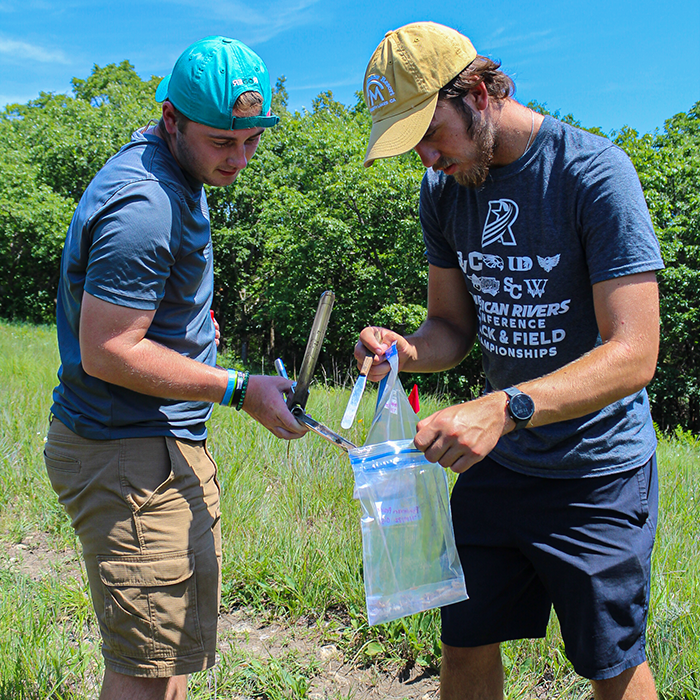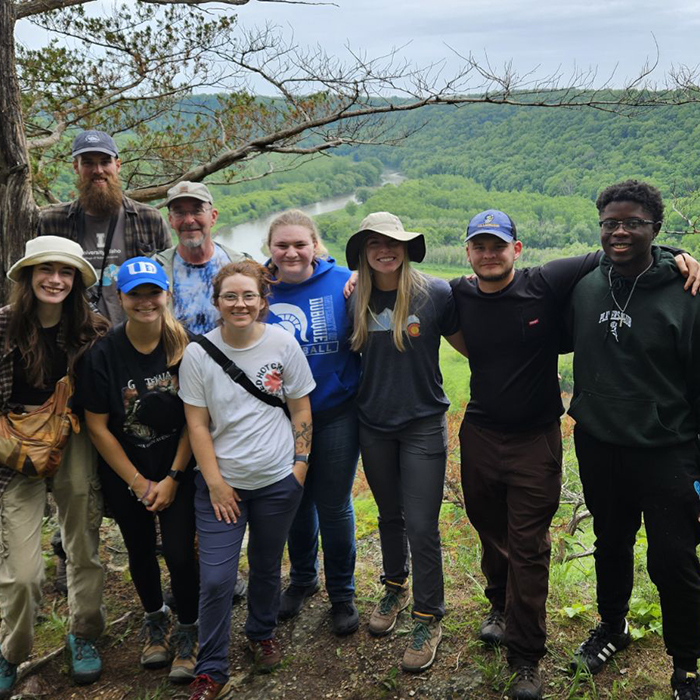CREATE Students Embrace Field Research
By Stacey Ortman
DUBUQUE, Iowa - When University of Dubuque student Joseph Ensley joined the first cohort of the Connecting Research, Experiences, and Application to Engagement (CREATE) program, he wasn't a plant-oriented person. That all changed this summer as he conducted field research to compare restored prairies to native prairies throughout Dubuque County.
"It's definitely been good for expanding my knowledge. For example, I got to learn some basics of botany before I actually take botany in the fall. CREATE is helping to tie my research and coursework together," said Ensley, a junior biology and chemistry double major.
The new program at UD was funded by a grant from the National Science Foundation's Scholarships in Science, Technology, Engineering, and Mathematics (S-STEM) program to support building a sense of belonging for students in STEM through research, networking, and community engagement. CREATE will build four cohorts of six students over the six years of grant support. Those students will carry out team-based, student-driven research projects under the mentorship of faculty.
This summer, the first cohort of six students began their work on projects dealing with the overarching themes of prairie restoration, vertebrate ecology, and water quality. The themes were purposefully broad so students could have a part in designing their own project.
"The students' projects will continue into the remainder of their education at UD. This summer has been focused on collecting samples and information. The future steps will be analyzing and collecting data from this to answer their research questions and then finally sharing this information at conferences and in publications," said Kelly Grussendorf, PhD, director of CREATE and associate professor of biology.
Projects have a field component, microbial or molecular component, and chemical analysis component to allow students to learn various types of skills and interact with the CREATE faculty. Students conducted their field work individually and as a team to learn about each other's projects.
"I get so excited about a couple things. First, the science behind it and the information the students are going to learn while doing it. They get to make discoveries and answer the questions they came up with. They will know answers and information that no one else will know, and then they get to share it. Second, seeing the students gain confidence and excitement in their projects. The students started out so nervous, barely talking, and shy the first week. But in this group, they all grasped onto their projects quickly and you can see how they have taken complete ownership of their projects as well as bonded with professors and other students. They have embraced their 'inner nerd' and get excited about things like different levels of chemicals in water, the amount of data they have collected, or the different types of birds they have caught. It is so much fun," Grussendorf said.
For prairie restoration, students looked for photosynthetic production, took species and soil samples, and conducted earthworm counts. Rasika Mudalige-Jayawickrama, PhD, professor of plant biology, mentored students as they visited Bowstring Wildlife Area, Mines of Spain Recreation Area, Miller-McGrath Wildlife Area, Pohlman Prairie Preserve, Proving Grounds Recreation Area, Ringneck Ridge Wildlife Area, Swiss Valley Park, UD's Wolter Woods and Prairies Environmental Stewardship and Retreat Center, and Whitewater Canyon Wildlife Area.
"I personally think that doing this research and participating in this program is an investment in my future and the future of other generations in this program because the research that we're doing now is going to help guide the research of future members of this program and hopefully they can expand on our baseline research in these projects," Ensley said.
For vertebrate ecology, Grussendorf and Gerald Zuercher, PhD, director of Wolter Woods and Prairies, helped students as they collected samples from birds to compare the presence of parasites from birds in town and those out of town. Their field work was conducted at Wolter Woods and Prairies as well as in the yards of Zuercher, Adam Hoffman, PhD, professor of environmental chemistry, and Ellen Carr, MBA, director of the Office of Vocation, Career Services, and Community Engagement.
"Of course, I love teaching and being in the classroom but getting out into the field and doing the science is another joy of being a professor at UD. It reminds us faculty of why we got into science in the first place. I think this is one thing that has pushed us into being professors, we are able to share our knowledge as well as continue participating in the science as well," Grussendorf said.
For water quality, students collected water samples and searched for mussels under Hoffman's guidance on the Mississippi River and area waterways that empty into the Mississippi River. On the river, they tested around Nine Mile Island, Mud Lake Park, and Hurricane Island. They also took samples at Catfish Creek, Bee Branch Creek, and the Little Maquoketa River.
"We are out there for quite a few hours, but on a summer day there's probably nowhere else I'd rather be," said Alyssa Straka, a junior biology major researching water quality, adding, "It's kind of a thrill when you find a new species that you haven't found before."
In the midst of collecting samples in the field, students and faculty created new bonds.
"I think getting to spend time with the professors outside of the classroom helped nurture your in-class relationship with the professors. The more comfortable you are with a professor, the more comfortable you are with asking questions. By asking questions, you are able to expand your knowledge and learn more and the professors are able to help you more efficiently and effectively," Ensley said.
CREATE faculty learned from their colleagues right along with the students while working in the field together across all three projects.
"This has been a great part of CREATE, and I think that it helps the students too. For example, before this started, I pretty much could only identify a robin and a cardinal, but now I can identify most birds in the area. This allows the students to see that as professors we know a lot and we have our expertise's, but we do not know everything and that we must continue to learn too," Grussendorf said, adding, "But outside of the scientific skills, I have learned how other faculty members mentor and advise students and it has exposed me to different methods that I have not tried but might in the future."
Next summer, the first cohort of students will continue their research and pass on the lessons they learned as mentors to the second cohort of students.
"I think it will be a lot of fun. We have been mentoring each other in a way because we all have our own individual projects and we teach each other whatever procedures we are doing. I'm looking forward to helping the next group," said Samantha Scodeller, a junior biology major researching vertebrate ecology.
For more photos from the field, visit www.facebook.com/UDubuque.



